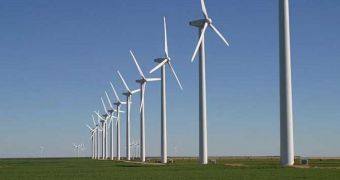According to a new study compiled by experts at the University of Albany, State University of New York, it would appear that land surface temperatures increase in areas where wind turbines and wind farms are installed.
The investigation covered an area in Texas where four of the largest wind farms in the world are installed. Over the past 9 years, scientists measured a significant increase in surface temperatures, and the new study demonstrated conclusively that the localized effects were caused by the turbines.
Experts determined the warming rate to be around 0.72 degrees Celsius per decade, as compared to nearby regions where no wind farms or turbines were installed. The study region is located in west-central Texas.
According to the research, the warming effect is most likely caused by the turbulences that develop in the turbines' wakes. These airflow disturbances act like giant fans, pulling down hot air from the atmosphere, especially during the night.
The research team that conducted the investigation was coordinated by UA expert Liming Zhou. He was also the lead author of a new paper detailing the findings, which appears in the April 29 issue of the top scientific journal Nature Climate Change.
For this research, experts had access to data collected by the Moderate-resolution Imaging Spectroradiometer (MODIS) instruments aboard the NASA Aqua and Terra satellites. The datasets revealed land surface temperatures from 2003 to 2010.
Rather than using air temperatures as their focal point, scientists actually used ground surface temperature values. Usually, the nature of the surface and the type of cover it has are the main factors determining how hot or cold it will be.
In some areas, air temperatures remain relatively constant, whereas land surface temperatures vary widely from day to night. Using MODIS data, researchers determined that the ground underneath the wind farms was mostly heating up at night.
Interestingly, the opposite effect was not observed during the day, as investigators expected. They noticed a slight warming of the ground, or no effect at all. On the bright side of things, the team says, this localized effect is not likely to influence global warming in any meaningful way.
“This is a first step in exploring the potential of satellite data to quantify the possible impacts of big wind farms on weather and climate,” says the chair of the UA Atmospheric and Environmental Sciences Department, Chris Thorncroft, who is also a coauthor of the study.
“We are now expanding this approach to other wind farms and building models to understand the physical processes and mechanisms driving the interactions of wind turbines and the atmospheric boundary layer near the surface,” he concludes.

 14 DAY TRIAL //
14 DAY TRIAL //